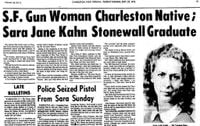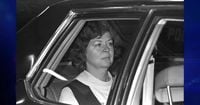Sara Jane Moore, the woman whose failed attempt to assassinate President Gerald Ford in 1975 made her a notorious figure in American history, died on Wednesday, September 24, 2025, at the age of 95. Her death at a nursing home in Franklin, Tennessee, was confirmed by Demetria Kalodimos, a journalist with the Nashville Banner, who had been informed by the executor of Moore’s estate. The news was first reported by the Nashville Banner and subsequently covered by major outlets including The New York Times and The Washington Post.
Moore’s name is forever linked to one of the most dramatic moments of political violence in the United States. On September 22, 1975, in San Francisco’s bustling Union Square, Moore—then 45 years old—fired two shots at President Ford as he waved to a crowd outside the St. Francis Hotel. The scene was chaotic, with about 3,000 people gathered for a glimpse of the President. Moore’s first shot missed its mark, and as she prepared to fire again, Oliver Sipple, a former Marine standing nearby, lunged forward and deflected her arm. The second bullet ricocheted off a wall and grazed a bystander, while Ford was quickly whisked away to safety by Secret Service agents.
Moore’s actions shocked the nation, not least because they came just 17 days after another woman, Lynette "Squeaky" Fromme—a follower of Charles Manson—had also attempted to kill Ford in Sacramento. The two women, both with West Virginia connections, did not know each other, and Moore later insisted she was not inspired by Fromme’s earlier act. According to the Charleston Gazette-Mail, Moore’s attempt occurred just two days after the 50th anniversary of her crime, a grim reminder of the era’s turbulence.
Born Sara Jane Kahn on February 15, 1930, in Charleston, West Virginia, Moore’s early life gave little hint of the notoriety to come. She graduated from Stonewall Jackson High School in 1947, the daughter of a DuPont engineer and a concert violinist. Over the years, she changed her name to Moore, adopting her mother’s maiden name, and embarked on a life marked by multiple marriages, name changes, and a complicated relationship with both radical politics and law enforcement. She joined the Women’s Army Corps, worked as an accountant in Hollywood, and eventually found herself drawn into the radical activism of California in the late 1960s and 1970s.
By 1974, Moore was living in San Francisco with her youngest son and working for People in Need, a food distribution program established by Randolph Hearst after his daughter Patty was kidnapped by the Symbionese Liberation Army. Moore’s political journey took her to the fringes of extremist groups, but she also served as an informant for both the FBI and San Francisco police. Her status as an informant became known among leftist circles, leading to her ostracization and increasing paranoia. As she later explained to KGO-TV in 2009, “I had put blinders on, I really had, and I was listening to only ... what I thought I believed. We thought that doing that would actually trigger a new revolution.”
Moore’s mental state and motives were the subject of intense scrutiny at her trial. Doctors found her legally sane, but her defense attorney, James F. Hewitt, recalled, “I never got a satisfactory answer from her as to why she did it. There was just bizarre stuff, and she would never tell anyone anything about her background.” According to The New York Times, investigators found no evidence of a conspiracy, and Moore pleaded guilty to attempted assassination in December 1975. She was sentenced to life in prison, joining a list of infamous would-be presidential assassins.
Moore’s time in prison was eventful. In February 1979, she and another inmate escaped from the minimum-security federal prison camp at Alderson, West Virginia, by scaling a 12-foot fence. The freedom was short-lived; she was recaptured about four hours later, roughly ten miles from the prison, while trying to hitchhike with her fellow escapee. In a 2009 interview on NBC’s “Today” show, Moore quipped, “If I knew that I was going to be captured several hours later, I would have stopped at the local bar just to get a drink and a burger.”
During her incarceration, Moore underwent a religious conversion, switching from Christianity to Judaism in 1986—a decision she once said was motivated by a desire for better prison meals, according to biographer Geri Spieler. Despite her notoriety, Moore largely faded from public view after her parole on December 31, 2007, having served 32 years of her life sentence. She moved to an undisclosed location under an assumed name and rarely gave interviews, though she occasionally reflected on her actions with a mix of regret and candor. In one interview, she stated, “I am very glad I did not succeed. I know now that I was wrong to try.”
Moore’s family life was as complicated as her political one. She was estranged from her children, having given up her three eldest to her parents, and her later marriages ended in divorce or, in the case of her final husband, Philip Chase, widowhood. As The New York Times noted, her life was marked by contradictions and reinventions, making her both a figure of fascination and confusion.
President Ford, for his part, survived two assassination attempts within a month and remained committed to public engagement. “If we can’t have the opportunity of talking with one another, seeing one another, shaking hands with one another, something has gone wrong in our society,” he said after the attacks. Ford died in 2006, a little more than a year before Moore’s release from prison.
Moore’s story has been immortalized in popular culture as well. She became a character in Stephen Sondheim’s musical Assassins, portrayed as a hapless revolutionary—"a true flibbertigibbet," as one critic put it, more likely to pull a banana from her handbag than a gun. Her life and motivations remain the subject of biographies and ongoing fascination, a testament to the enduring questions her actions raised about political violence, radicalization, and the unpredictable paths of American history.
As the news of her death settles, Moore’s life stands as a complex chapter in the nation’s story—one marked by turmoil, regret, and the sobering reminder of how one person’s choices can reverberate for decades.


